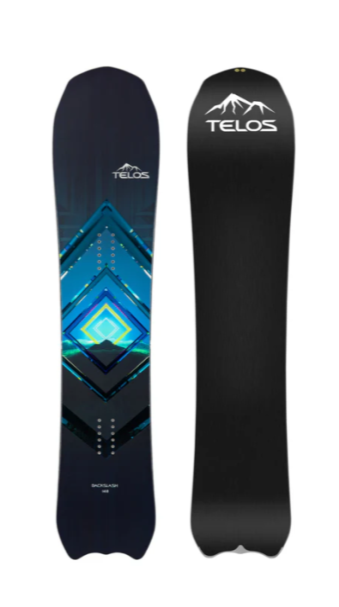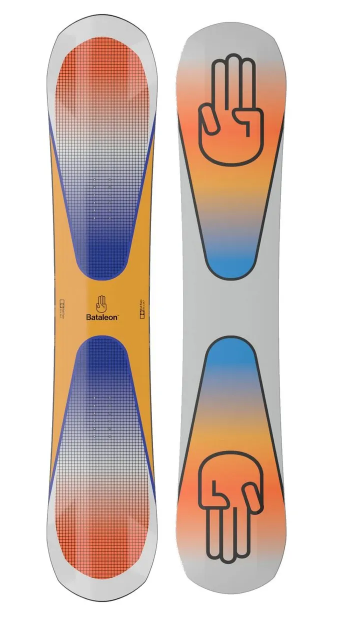DIRECTIONAL VS. TRUE TWIN VS. DIRECTIONAL TWIN SNOWBOARDS. WHAT’S THE DIFFERENCE?
Telos Back/Slash - Directional Snowboard
Bataleon Evil Twin - True Twin Snowboard
Capita Mercury - Directional Twin Snowboard
What's the Difference?
Believe it or not, this has been a bit of a subject of debate throughout the years of snowboard history. But there is an actual, definitive answer to this question, and although there are many subtle variations and nuances, it ultimately comes down to taper and symmetry.
In short, if a snowboard has taper, it is a directional snowboard, PERIOD.
If a snowboard is perfectly symmetrical from nose to tail (meaning if you cut it in half, the nose and tail would be identical in every way, then it is a true twin snowboard.
Everything in between is a directional twin.
For example, a twin snowboard will have the same width in the nose and tail (i.e., no taper). This is what keeps it in the twin category, and not the directional category.
But if you:
Make the nose a bit longer than the tail
Set the binding inserts back slightly
Move the sidecut back
Shape the tail differently than the nose
Give it a directional flex(i.e. softer nose & stiffer tail)
Or alter the symmetry of the board in any way (other than the nose and tail width) then it becomes a directional twin.
Depending on the extent of these alterations, you will hear things like “slightly directional twin”, “super directional”, “rides like a twin”, “twin”(not to be confused with true twin), etc. All of these terms and sayings allude to the level of extremity of the alterations that have been made to the ‘base symmetrical snowboard design’. Due to all of the possible alterations, there is a wide range of directional twins to choose from.
Directional twins with minor alterations are closer to the true twin side of the spectrum, and directional twins with heavier alterations are closer to the directional side of the spectrum.
Directional boards have a wide spectrum of their own as well. Some have a more mellow taper, setback, shape, profile, construction, etc., while others have a more aggressively directional design.
The head snowboard engineer at K2, Justin Clark (J-stone), explains this more in-depth on his Bomb Hole Episode below:
Watch the Full Video on YouTube from the Bomb Hole here.
Why Does It Matter?
Now that we have the technicalities out of the way, why should you care if a snowboard is a true twin, directional, or a directional twin? And which shape is best for you and your riding style?
True Twin
A true twin snowboard is best for general freestyle riding, because it rides the same regular or switch/fakie(your non-dominant direction). So if you want to land or take off switch, then the true twin will perform the same in either situation. This goes for the flex as well, where you can ollie or nollie(ollie off the nose) without any performance variation. So if you like to ride park, jib, spin, and jump off every bump, roller, and side-hit on the mountain, then a true twin is likely the best shape for you.
Directional Twin
As you start lengthening the nose or setting back the binding inserts, you might start to notice the board riding a little differently when riding switch. But small adjustments are typically not that noticeable and don’t greatly impact your ability to ride, take off, or land switch; just something you have to get used to.
At the same time, this CAN GREATLY improve your ability to float in powder, get in and out of turns, have more control at higher speeds, and cruise over the top of rougher snow.
This is what makes directional twins great for all-mountain riders. Those who want to ride a bit of park, jump some rollers/side-hits, cruise the trees, carve the blues, and smash pow whenever possible.
It is the most versatile shape and lends itself to all facets of riding. These are known as your “quiver killers”, the first and last board you’ll ever need, the “quivers of one”, the ONE BOARD TO RULE THEM ALL!!!
Ahem…moving on. As mentioned previously, the more alterations you make to a twin design, the closer to a directional design you get. Those with more minor alterations are meant for riding the whole mountain with more freestyle flair.
Those with a more moderate amount of alterations can truly be used for everything on the mountain (quiver killers).
And those with heavy alterations are intended for riding the whole mountain with more of a freeride focus. (Freeride includes carving, high speeds, powder, and general off-piste shredding).
Within this wide spectrum, you can choose the exact level of freeride vs. freestyle focus to match your personal style by choosing how “extreme” the alterations are on your directional twin snowboard.
Directional
With all of these infinite combinations of design variations, as soon as you make the tail narrower than the nose (taper) you are now dealing with a directional shape. Directional boards are where you will feel a more significant difference when riding switch, where you will notice a larger advantage staying afloat in deep snow, and where carving starts to change.
For example, the way the board enters and exits turns is a different experience. There’s a noticeable “hook” on the exit that helps “spring” you out of turns. This sets you up for a smooth arching line into your next turn. You can put more weight onto your front foot to really drive into those turns and carve down the mountain. In deep snow, you don’t need to put your weight back as much, as the nose will naturally want to stay on top.
Similar to Directional Twins, there is a wide range of Directional boards with varying levels of directionality. Some with more aggressive tapers, shapes, profiles, and construction. Others with more mellow tapers, shapes, profiles, and construction. Once again, allowing you to choose exactly the type of ride that fits your style.
Overall, a directional shape allows you to commit harder to your line and shred the gnarliest terrain with more confidence. Ideal for riders who want to ride hard, go fast, carve trenches, smash pow, and access all parts of the mountain.
Conclusion
Having a taper is what makes a board directional. Having a perfectly symmetrical board nose to tail is what makes a board a true twin. All variations in between are directional twin snowboards. In general, a true twin snowboard will work best for a freestyle-focused riding style, a directional board will work best for a freeride-focused riding style, and a directional twin will work best for a mix of both.
Choosing the right shape for you will help you to progress faster, snowboard more, and have more fun riding. Whereas the “wrong” shape will slow your learning curve, hinder your progression, and hold you back from getting the most out of your days on the mountain.
To be fair, if you know how to ride a snowboard you can ride it anyway and anywhere you want. But just because you can doesn’t mean you should. If you want the best tool for the job and to get the most out of your riding, then choosing the shape that matches your riding style best is a critical decision.
So find your personal style, choose the shape that complements it best, and go have fun shredding!
-Cheers
If you have any questions or want to dive deeper on a specific snowboard, check out our Gear Advice Portal here.
Some of our favorite True Twins:
Ride Zero
K2 Afterblack
Capita Indoor Survival
Some of our favorite Directional Twins:
Ride Shadowban
Bataleon Beyond Medals
Some of our favorite Directional Snowboards:
Check out our list of Top 10 All-Mountain Freestyle Boards here.




